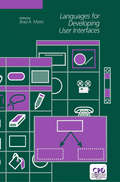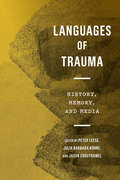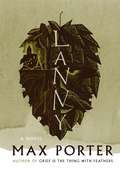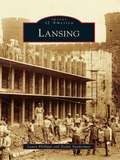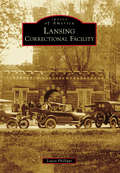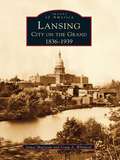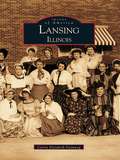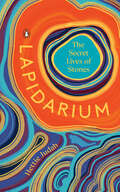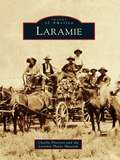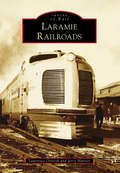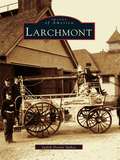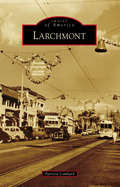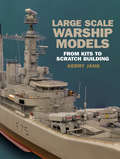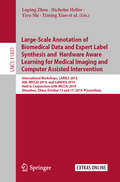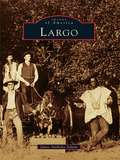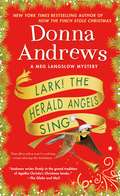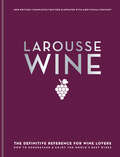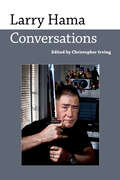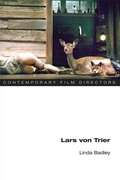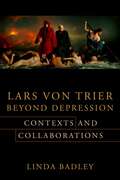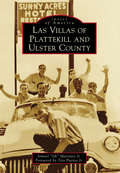- Table View
- List View
Languages for Developing User Interfaces
by Brad A. MyersThis book brings together a number of researchers and developers from industry and academia who report on their work. It is of interest to language designers and the creators of toolkits, UIMSs, and other user interface tools.
Languages of Trauma: History, Memory, and Media (G - Reference,information And Interdisciplinary Subjects Ser.)
by Peter Leese Jason Crouthamel Julia Barbara KöhneThis volume traces the distinct cultural languages in which individual and collective forms of trauma are expressed in diverse variations, including oral and written narratives, literature, comic strips, photography, theatre, and cinematic images. The central argument is that traumatic memories are frequently beyond the sphere of medical, legal, or state intervention. To address these different, often intertwined modes of language, the contributors provide a variety of disciplinary approaches to foster innovative debates and provoke new insights. Prevailing definitions of trauma can best be understood according to the cultural and historical conditions within which they exist. Languages of Trauma explores what this means in practice by scrutinizing varied historical moments from the First World War onwards and particular cultural contexts from across Europe, the United States, Asia, and Africa – striving to help decolonize the traditional Western-centred history of trauma, dissolving it into multifaceted transnational histories of trauma cultures.
Lanny: A Novel
by Max PorterLonglisted for the 2019 Booker PrizeAn entrancing new novel by the author of the prizewinning Grief Is the Thing with FeathersThere’s a village an hour from London. It’s no different from many others today: one pub, one church, redbrick cottages, some public housing, and a few larger houses dotted about. Voices rise up, as they might anywhere, speaking of loving and needing and working and dying and walking the dogs. This village belongs to the people who live in it, to the land and to the land’s past.It also belongs to Dead Papa Toothwort, a mythical figure local schoolchildren used to draw as green and leafy, choked by tendrils growing out of his mouth, who awakens after a glorious nap. He is listening to this twenty-first-century village, to its symphony of talk: drunken confessions, gossip traded on the street corner, fretful conversations in living rooms. He is listening, intently, for a mischievous, ethereal boy whose parents have recently made the village their home. Lanny.With Lanny, Max Porter extends the potent and magical space he created in Grief Is the Thing with Feathers. This brilliant novel will ensorcell readers with its anarchic energy, with its bewitching tapestry of fabulism and domestic drama. Lanny is a ringing defense of creativity, spirit, and the generative forces that often seem under assault in the contemporary world, and it solidifies Porter’s reputation as one of the most daring and sensitive writers of his generation.
Lansing (Images of America)
by Nolan Sunderman Laura PhillippiFounded by Civil War veteran William Lansing Taylor, Lansing is home to a population quickly approaching 11,000 residents. It is also home to the Lansing Correctional Facility (formerly the Kansas State Penitentiary), the oldest prison in Kansas. Designed by Erasmus Carr, architect of the Kansas State Capitol, the building has stood watch over the area for more than 140 years. As one will find, Lansing and the prison have grown together and mutually benefitted each other. Lansing is also home to Mount Muncie Cemetery, one of the oldest cemeteries in the state. It is the resting place of several famous people, including Fred Harvey. The photographs in this book are glimpses into time of a small village with one-room schools to a bustling community with one of the busiest north-south highways in Kansas.
Lansing Correctional Facility
by Laura PhillippiSince 1868, the Lansing Correctional Facility (formerly the Kansas State Penitentiary) has stood watch over what would become the city of Lansing. Designed by Erasmus Carr, architect of the Kansas State Capitol, the prison is the oldest in Kansas. In the beginning, it housed male and female inmates from Kansas and Oklahoma, as well as inmates serving federal sentences. Today, the facility's population of minimum, medium, maximum, and special management custody offenders is approximately 2,400. Leavenworth County has also seen the addition of the United States Disciplinary Barracks, United States Penitentiary-Leavenworth, and Corrections Corporation of America-Leavenworth, making it the only county in the country to host a state, military, federal, and private prison. Images of America: Lansing Correctional Facility features photographs of the early days, when inmates were on the "silent system" and could not speak to one another, to more modern times when rehabilitation has become an important component of prison life.
Lansing, City on the Grand: 1836-1939 (Images of America)
by James Maclean Craig A. WhitfordLansing's history as the capital of Michigan began with a legislative mandate in the 1835 State Constitution, which required that the seat of government be moved from Detroit in 1847. The result-the emergence of a new capital city on the banks of the majestic Grand River-allowed Lansing to cultivate a world-class community based in government, education, the automotive industry, and entrepreneurial achievements. This book features more than 200 historic photographs that document the dynamic capital city during its pivotal first century, from the pioneer era to the inception of the Olds Motor Vehicle Company and through the eve of World War II.
Lansing: Illinois (Images of America)
by Carrie Elizabeth SteinwegLansing, Illinois, is a village that is "proud of its past, confident in its future," according to the signs at its entrance. That proud past began in the 1840s, when Dutch and German settlers first made their way to the area. The town was named for Henry Lansing, who came to the area in 1846 with his brothers, John and George. Through the medium of historic photographs, this book captures the evolution of the people of Lansing, from the late-1800s to the present day. These pages bring to life the people, events, communities, and industries that helped to shape and transform Lansing. With nearly 200 vintage images, Lansing, Illinois, includes photographs of the Indiana Avenue School, the Brickyards, the Ford Airport, and early businesses and business owners. It is hard to imagine Ridge Road, now a bustling center of commerce, as a dirt road scattered with general stores, taverns, and blacksmith shops. This book will take you back to Lansing's simpler days to give the reader a glimpse of why this community has maintained its appeal and held generations of families here in this warm and friendly place.
Lapeer Area, The
by Catherine Ulrich BrakefieldLegends about the Ottawa, Chippewa, and Nepessing Indians have left an indubitable mark upon the Lapeer area. Streets, rivers, and towns sing out the melody of their ageless legacy, just as those first settlers of Lapeer left their footprints upon the towns and cities for generations to follow. Like a comfortable rocker, the lyrics of hospitality linger, whispering of a way of life not easily left within the pages of a history book. Frugal, yet compassionate, these early pioneers shared their meager provisions and scant shelters with the tribes and wayward travelers alike. Lumberjacks sawed and farmers harvested their crops, threshed their grain, raised their barns, and worshipped together. Feuds never lasted and families never parted. The people of the Lapeer area worked, voted, and played together, creating a place of beauty for the generations they would never know. The gentle rolling hillsides still ring with their music, whether it is the moccasin footsteps of the first hunter, the boot-clad lumberjack or farmer, or the European tradition of riding to the hounds-for here the panoramic view of the Lapeer area comes alive with heritage, horses, and hills.
Lapidarium: The Secret Lives of Stones
by Hettie JudahInspired by the lapidaries of the ancient world, this book is a beautifully designed collection of true stories about sixty different stones that have influenced our shared historyThe earliest scientists ground and processed minerals in a centuries-long quest for a mythic stone that would prolong human life. Michelangelo climbed mountains in Tuscany searching for the sugar-white marble that would yield his sculptures. Catherine the Great wore the wealth of Russia stitched in gemstones onto the front of her bodices. Through the realms of art, myth, geology, philosophy and power, the story of humanity can be told through the minerals and materials that have allowed us to evolve and create. From the Taiwanese national treasure known as the Meat-Shaped Stone to Malta&’s prehistoric &“fat lady&” temples carved in globigerina limestone to the amethyst crystals still believed to have healing powers, Lapidarium is a jewel box of sixty far-flung stones and the stories that accompany them. Together, they explore how human culture has formed stone, and the roles stone has played in forming human culture.
Laramie
by Laramie Plains Museum Charlie PetersenWhile it was still part of Dakota Territory, the town of Laramie was founded in 1868 with the arrival of the Union Pacific Railroad. Laramie's placement on the high plains at an elevation of 7,200 feet hasnot made for an easy existence, but the hardy ranching families and cowboys, with their cattle hunkered down against the winds and snow, survived in spite of their harsh surroundings and even thrived in this unique eastern Wyoming town. This is the place where the infamous Jack McCall hid from the authorities, where Teddy Roosevelt rode the range, and where Butch Cassidy was held at the Wyoming Territorial Prison. From its early, rowdy days as an end-of-the-tracks tent town on the railroad, with gambling halls and an active nightlife, through the growing-up years of mills, quarries, and local wartime heroes, to the establishment of Wyoming's only state university, Laramie's remarkable story is told here through historic photographs.
Laramie Railroads
by Jerry Hansen Lawrence OstreshOn July 1, 1862, President Lincoln signed the Pacific Railway Act. This act created the Union Pacific Railroad and authorized government loans and land grants to aid in the construction of the nation's first transcontinental railroad, which would connect Omaha, Nebraska, to Sacramento, California. As the Union Pacific raced west across prairies, mountains, and basins in 1867 and 1868, the Territory of Wyoming and many of its southern towns and cities were founded, including Laramie. In 1869, the Union Pacific met the Central Pacific at Promontory Summit, Utah, and the transcontinental railroad was complete. This is the story of the railroads of Laramie, a fabled place along the Union Pacific's Overland Route.
Larchmont
by Judith Doolin SpikesLarchmont has always been distinguished from other settlements north of New York City by its thirteen acres of public-access shoreline and glaciated coast on Long Island Sound. Settled in the early 1800s, it became a resort community after wealthy New Yorkers began buying up abandoned farmland to create country estates. It rose to international fame on the coattails of the Larchmont Yacht Club.
Larchmont
by Patricia LombardLarchmont Boulevard is more than a street; it is the soul and spine of the surrounding neighborhoods created in the early 1900s when Los Angeles was just coming into its own. Located in the heart of Los Angeles, Larchmont Boulevard is a charming, walkable street running north and south from Third Street to Melrose Avenue that gives residents and visitors the feeling of a small town tucked inside the vast, car-centric city of Los Angeles. This book tells the story of Larchmont's beginnings in 1921 when the Los Angeles Times reported that developers Julius La Bonte and Charles Ramson had purchased seven lots on Larchmont Boulevard to create a business district of 30 stores between First Street and Beverly Boulevard. The one-block stretch, where a trolley line once ran, is affectionately known as "the village" by locals in the surrounding neighborhoods of Brookside, Citrus Square, Country Club Heights, Fremont Place, Hancock Park, La Brea-Hancock, Larchmont Village, Melrose, Oakwood-Maplewood-St. Andrews, Ridgewood-Wilton/St. Andrews Square, Sycamore Square, Western-Wilton, Wilshire Park, Windsor Square, and Windsor Village.
Large Scale Warship Models: From Kits to Scratch Building
by Kerry JangThis illustrated guide presents step-by-step instructions and techniques for warship modelers ready for the challenge of building at larger scales. Many warship modelers who work in smaller scales are daunted by the challenge of tackling something larger. But in Large Scale Warship Models, expert modeler Kerry Jang demonstrates that it&’s not as difficult as it may seem. In fact, any experienced modeler will already possess the basic skills required. This volume covers the essential new techniques for working in scales that capture the grandeur of actual ships. In the first part of the book, Jang discusses how to choose between a kit, a semi-kit or building from scratch. He also covers what conventional kit building skills are transferable to work on large-scale projects. Novel requirements like research, obtaining plans and sourcing material or fittings are also covered. The second part describes building methods, including the latest techniques like casting fittings in resin. These methods apply to both static and radio-controlled models. Original color photos illustrate each chapter, and the book concludes with a gallery of superb models intended to inspire the would-be large-scale warship modeler to take the plunge.
Large-Eddy Simulation Based on the Lattice Boltzmann Method for Built Environment Problems
by Mengtao Han Ryozo OokaThis book details the lattice Boltzmann method (LBM) applied to the built environment problems. It provides the fundamental theoretical knowledge and specific implementation methods of LBM from the engineering perspective of the built environment. It covers comprehensive issues of built environment with three detailed cases, solving practical problems. It can be used as a reference book for teachers, students, and engineering technicians to study LBM and conduct architecture and urban wind environments simulations, in the fields of architecture, building technology science, urban planning, HVAC, built environment engineering, and civil engineering.
Large-Scale Annotation of Biomedical Data and Expert Label Synthesis and Hardware Aware Learning for Medical Imaging and Computer Assisted Intervention: International Workshops, LABELS 2019, HAL-MICCAI 2019, and CuRIOUS 2019, Held in Conjunction with MICCAI 2019, Shenzhen, China, October 13 and 17, 2019, Proceedings (Lecture Notes in Computer Science #11851)
by Emanuele Trucco Diana Mateus Veronika Cheplygina Yiming Xiao Hassan Rivaz Ingerid Reinertsen Matthieu Chabanas Raphael Sznitman Luping Zhou Yiyu Shi Nicholas Heller X. Sharon Hu Danny ChenThis book constitutes the refereed joint proceedings of the 4th International Workshop on Large-Scale Annotation of Biomedical Data and Expert Label Synthesis, LABELS 2019, the First International Workshop on Hardware Aware Learning for Medical Imaging and Computer Assisted Intervention, HAL-MICCAI 2019, and the Second International Workshop on Correction of Brainshift with Intra-Operative Ultrasound, CuRIOUS 2019, held in conjunction with the 22nd International Conference on Medical Imaging and Computer-Assisted Intervention, MICCAI 2019, in Shenzhen, China, in October 2019. The 8 papers presented at LABELS 2019, the 5 papers presented at HAL-MICCAI 2019, and the 3 papers presented at CuRIOUS 2019 were carefully reviewed and selected from numerous submissions. The LABELS papers present a variety of approaches for dealing with a limited number of labels, from semi-supervised learning to crowdsourcing. The HAL-MICCAI papers cover a wide set of hardware applications in medical problems, including medical image segmentation, electron tomography, pneumonia detection, etc. The CuRIOUS papers provide a snapshot of the current progress in the field through extended discussions and provide researchers an opportunity to characterize their image registration methods on newly released standardized datasets of iUS-guided brain tumor resection.
Largo
by James Anthony SchnurPioneer settlers came to the west-central Pinellas peninsula in the years before the Civil War. The arrival of the railroad in 1888 brought truck farmers and expansive citrus groves. Decades before the city's incorporation in 1905, Largo became an important area for raising livestock, harvesting crops and timber, and trading citrus. Largo's farmers fed nearby urban communities during the Florida land boom while also providing winter fruits and vegetables to distant markets. Packing houses dotted the rural landscape during the years prior to World War II. By the 1960s, Largo expanded eastward toward Tampa Bay as new subdivisions sprouted in former groves. Known at various times as Citrus City, Fair City, Clean Air Capital, and City of Progress, Largo has grown from its roots as a small farming settlement to become the central crossroads and the third largest city in Florida's most densely populated county.
Lark! The Herald Angels Sing: A Meg Langslow Mystery (Meg Langslow Mysteries #24)
by Donna AndrewsAway in a manger, asleep on the hay, Meg Langslow finds a little gift.For four previous Christmases, New York Times bestselling author Donna Andrews has delighted readers with holiday mysteries, full of Christmas cheer and starring her quirky characters. Now she gives us another hilarious new adventure in her award-winning Meg Langslow series with Lark! The Herald Angels Sing. It’s Christmastime in Caerphilly and Meg, full of holiday spirit, is helping out with the town's festivities. While directing a nativity pageant and herding the children participating in it, she finds a surprise in the manger: a live baby. A note from the mother, attached to the baby girl’s clothes, says that it’s time for her father to take care of her—and implicates Meg’s brother, Rob, as the father. And while a DNA test can reveal whether there's any truth to the accusation, Rob's afraid the mere suspicion could derail his plan to propose to the woman he loves. Meg quickly realizes it's up to her to find the baby's real identity.She soon discovers that the baby—named Lark according to the fateful note—may be connected to something much bigger. Something that eventually puts a growing number of Meg’s friends and family in danger. And before long, Meg realizes she can’t fix things single-handedly. Meanwhile, a war is brewing between Caerphilly and its arch-rival Clay County—and it's not a snowball fight. Can Meg bring everyone together in time for the holidays?As in her previous Christmas mysteries, Andrews continues to write “firmly in the grand tradition of Agatha Christie’s Christmas books” (Toronto Globe and Mail) with a book that will put cozy lovers everywhere in a holly jolly mood.
Larousse Wine: The World's Greatest Vines, Estates, And Regions
by David Cobbold Sebastian Durand-VielAn expert guide to wine from the publishers of Larousse Gastronomique. This completely new and updated edition offers wide-ranging coverage of the key wine-producing regions of the world, with particular reference to French vineyards.A short history and analysis of each region is followed by a survey of the types of wines produced, the specific properties that make the region unique, and the appellations of the area. New to this edition are more than 60 features on key wine producers around the world, affording a fascinating insight into what is involved in high-quality wine-making. Boxes and features throughout also cover a vast range of subjects such as how to read a wine label and whether to decant wine, through to organic wine-growing and bio-dynamics.
Larry Hama: Conversations (Conversations with Comic Artists Series)
by Christopher IrvingLarry Hama (b. 1949) is the writer and cartoonist who helped develop the 1980s G.I. Joe toy line and created a new generation of fans from the tie-in comic book. Through many interviews, this volume reveals that G.I. Joe is far from his greatest feat as an artist. At different points in his life and career, Hama was mentored by comics legends Bernard Krigstein, Wallace Wood, and Neal Adams. Though their impact left an impression on his work, Hama has created a unique brand of storytelling that crosses various media. For example, he devised the character Bucky O'Hare, a green rabbit in outer space that was made into a comic book, toy line, video game, and television cartoon—with each medium in mind. Hama also discusses his varied career, from working at Neal Adams and Dick Giordano’s legendary Continuity to editing a humor magazine at Marvel, developing G.I. Joe, and enjoying a long run as writer of Wolverine. This volume also explores Hama's life outside of comics. He is an activist in the Asian American community, a musician, and an actor in film and stage. He has also appeared in minor roles on the television shows M*A*S*H and Saturday Night Live and on Broadway. Editor and historian Christopher Irving compiles six of his own interviews with Hama, some of which are unpublished, and compiled others that range through Hama’s illustrious career. The first academic volume on the artist, this collection gives a snapshot of Hama’s unique character-driven and visual approach to comics’ storytelling.
Lars von Trier (Contemporary Film Directors)
by Linda BadleyScandinavia's foremost living auteur and the catalyst of the Dogme95 movement, Lars von Trier is arguably world cinema's most confrontational and polarizing figure. Willfully devastating audiences, he takes risks few filmmakers would conceive, mounting projects that somehow transcend the grand follies they narrowly miss becoming. Challenging conventional limitations and imposing his own rules, he restlessly reinvents the film language. The Danish director has therefore cultivated an insistently transnational cinema, taking inspiration from sources that range from the European avant-garde to American genre films. This volume provides a stimulating overview of Trier's career while focusing on the more recent work, including his controversial Gold Heart Trilogy (Breaking the Waves, The Idiots, and Dancer in the Dark), the as-yet unfinished USA Trilogy (Dogville and Manderlay), and individual projects such as the comedy The Boss of It All and the incendiary horror psychodrama Antichrist. Closely analyzing the films and their contexts, Linda Badley draws on a range of cultural references and critical approaches, including genre, gender, and cultural studies, performance theory, and trauma culture. Two revealing interviews that Trier granted during crucial stages of Antichrist's development are also included.
Lars von Trier Beyond Depression: Contexts and Collaborations
by Professor Linda BadleyLars von Trier built a reputation as a provocateur from the start—but in the late 2000s, he entered an even more inflammatory phase. Amid Cannes controversies, Antichrist (2009), Melancholia (2011), Nymphomaniac (2013–14), and The House That Jack Built (2018) brandished the cinematic virtuosity von Trier once banned under the Dogme 95 Manifesto while subjecting audiences to “extreme” cinema. Following von Trier’s experience of clinical depression in 2006 and 2007, these films took an aggressively personal and retrospective turn against the backdrop of the director’s controversy-courting public appearances.Playing against widespread assumptions, Linda Badley takes a reparative approach, offering an in-depth examination of these four films and the contexts that produced them. Drawing on numerous interviews with the director and his collaborators as well as inside access to archival materials, she provides a thorough and comprehensive account of von Trier’s preproduction and creative process. Highlighting a transmedial turn, Badley tracks von Trier’s artistic touchstones from Wagner, Proust, and the Marquis de Sade to Scandinavian erotic cinema and serial killer genre tropes. She considers his portrayals of mental illness and therapy, gender and sexuality, nature and extinction, shedding light on the thematic concerns that unite these films as a distinct cycle. Offering nuanced readings of these films, the book emphasizes the significance of von Trier’s work for current critical and philosophical debates, showing how they engage with notions of the Anthropocene, “dark ecology,” and the postcinematic.
Laruelle and Non-Photography
by Jonathan FardyThis book provides a critical introduction to François Laruelle’s writings on photography, with a particular focus on his two most important books on photography: The Concept of Non-Photography and Photo-Fiction, a Non-Standard Aesthetics. By unpacking and contextualising these works, this study provides a useful starting point for students and scholars who want to better understand Laruelle’s larger project, which he calls “non-philosophy”, or more recently, “non-standard philosophy”. With clear and concise explanations of the basics of non-philosophy, Laruelle and Non-Photography demonstrates how Laruelle's thought challenges standard, philosophical approaches to photography, and culminates in a novel theory of "non-photography."
Las Vegas: 1905-1965 (Postcard History)
by Carey Burke Allen Sandquist Lynn ZookEveryone thinks they know the story of Las Vegas: the showgirls, the gambling, the mob. But Las Vegas has always been much more. Families have lived here since its founding in 1905. After 1931, legalized gaming became the big tourist draw, and following World War II, the town began to market itself as "America's Playground." That is when the famed Las Vegas Strip came into its own and downtown was dubbed "Glitter Gulch." These vintage postcards show how Las Vegas evolved from a dusty railroad town into the "Entertainment Capital of the World," while remaining a city filled with families and pioneering souls.
Las Villas of Plattekill and Ulster County (Images of America)
by Tito Puente Jr. Ismael Ish" Martinez Jr.This is the first comprehensive historical retrospective on Las Villas of Plattekill and Ulster County ever written. Ulster County was first settled in 1652 and officially became a county in 1683. Its rural nature, scenic beauty, and the Catskill Mountains have made it a popular vacation destination since the 19th century. Described in numerous news articles as the Spanish Alps, Las Villas, as they were collectively known, was a lively enclave of Spanish, Puerto Rican, and other Hispanic summer resorts in Plattekill, New York, and the Catskill Mountains. Starting in the 1920s and for the next 60 years, the area became the most popular vacation destination for Latinos in the Northeast, with an emphasis on music, food, language, and customs.
